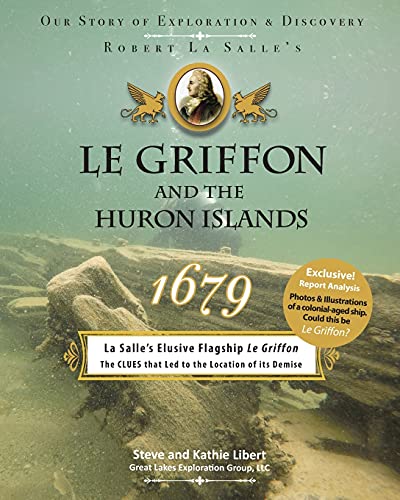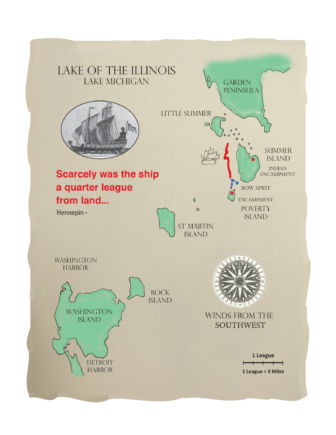By Eric Freedman
Capital News Service
Historical mysteries may take decades, even centuries, to solve – if ever.
In the Great Lakes region, there may be no older and more intriguing historical mystery than the 1679 disappearance of the Griffon, one of French explorer Robert La Salle’s ships.
Its fate has been a puzzlement for maritime historians for more than three and a half centuries.
Now after more than 40 years of searching, Charlevoix diver Steve Libert says he’s 99.99% sure he found the answer, and he tells how in a new book.
His conclusion: The remains of the ship – Le Griffon in French – sank in shallow water in the Huron Islands of northern Lake Michigan, northeast of Green Bay, Wisconsin, with the loss of all the crew members aboard.

Le Griffon and the Huron Islands, 1679. Image: Mission Point Press
Or not.
Other experts insist Libert’s absolutely wrong.
“The Griffon has not been found,” Wayne Lusardi, the state archaeologist in the Department of Natural Resources, says bluntly.
Valerie van Heest, a member of the board of directors of the Michigan Shipwreck Research Association, says, “There have been 30 or more ‘discoveries’ of the Griffon dating back to early 1800s. Every one of these shipwreck hunters finds a bone pile and claims it’s the Griffon.”
“All of those people have been wrong” – including Libert – she says.
Cathy Green, the executive director of the Wisconsin Maritime Museum in Manitowoc, is also skeptical, calling it “highly unlikely” that it’s the Griffon and “nearly impossible” to definitively know because of the centuries of damage to shallow water wrecks from ice, storms and rising and falling lake levels.
“It would be awesome” if true, she says, a story she’d love the museum to be able to tell visitors, with the aura of amateur treasure-hunting and Indiana Jones.
Green and Ken Vrana, the principal of Maritime Heritage Consulting, advocate an independent assessment by professionals.
“Until there is an expedition (to the site) with politically unaligned professionals, I will not weigh in one way or another,” said Vrana, whose nonprofit group has consulted with Libert.
Here’s the backstory as Libert tells it: LaSalle built the Griffon as his flagship upriver from Niagara Falls, probably on what is now the Canadian side of the Niagara River.
After launching, it sailed the Niagara River to Lake Ontario, onward to Lake Erie, then by way of the St. Clair River to Lake Huron and northward to St. Ignace, the Straits of Mackinac and, finally, Lake Michigan.

Map showing what Steve Libert believes were the final route and final resting place of the Griffon near the UP’s Garden Peninsula. Image: Steve and Kathie Libert
There the crew ignored a warning from local Native Americans not to sail into the lake from the safe harbor at Washington Island because of high wind danger from a massive storm.
La Salle – whose full name was the noble-sounding René-Robert Cavelier, Sieur de La Salle – wasn’t aboard the Griffon. He continued exploring the Mississippi River until his murder in Texas in 1687.
Libert became instantly fascinated by the Griffon mystery as a 14-year-old student in Dayton, Ohio, where he first heard from a teacher about the missing ship with its figurehead of a griffon, a mythical creature with the body of a lion and the head of an eagle.
“I was mesmerized by what he was saying. He walked right behind me and put his hand on my shoulder and said, ‘Perhaps someone in this class will find it someday.’ I was listening to every word,” says Libert, now 67.
He learned to dive, and the quest was on.
“We have been on the hunt for over 40 years systematically ferreting out the locations of this widely scattered wreck,” he says, referring to his wife Kathie and himself.
Libert says the evidence he’s amassed pinpoints where the wreckage of the 40- to 45-ton ship now rests: in shallow water near Poverty Island and Summer Island.
That evidence? French historical documents and shipbuilding techniques, colonial-era maps, contemporary reports, what he says is a bowsprit retrieved from the wreckage, carbon-4 dating and underwater photographs of submerged parts of a vessel.
He recounts his hunt and discovery in “Le Griffon and the Huron Islands, 1679” (Mission Point Press), written with his wife.
To skeptics who doubt Libert’s identification of the wreckage, he responds, “The clues are there.”
But wait, wait, wait.
Van Heest says the book’s account of the expedition from the Niagara River to Lake Michigan “has the facts down, but once we get to the story of the supposed bowsprit it all falls apart because it’s not a bowsprit.”
A bowsprit is the spar that extends forward from the bow.
She says American marine archaeologists concluded that what Libert claims is the bowsprit was “beyond a doubt” part of a Native American fishing trap. Acknowledging that French archeologists side with Libert, she asks what they know about Native American fishing practices.
As for the pieces of wreckage Libert photographed, they can’t be the Griffon’s because they would have broken to bits long, long ago if they’d been in shallow water battered by storms and ice for more than three centuries, van Heest says.
“I’ve seen dozens and dozens of 100- to 150-year-old ships, and that is not a 350-year-old ship. It would no longer exist. It would be busted up,” she said.
“Where are the cannons? That is my question. Wood can break up. A ship in shallow water gets beat up quickly. Wherever the Griffon is, if it’s in deep water somewhere, there are cannons near it,” she says.
No cannons have been found near the site Libert identified.
But Libert says, “Many people believe I continue to cry wolf and contact the press every time we find a wreck claiming them to be the Griffon. That is simply not true.”
So, if the Griffon’s final resting place isn’t where Libert believes it to be, where is it?
Van Heest responds, “Most people that are not dreamers say that for it to still exist, it must be in deep water not affected by ice and storms.”
Maritime historians’ best guess, she says, is that it sank between Beaver Island and the southern coast of the Upper Peninsula, possibly within sight of shore between what are now Manistique and Naubinway.
“If it exists in the physical world, we think it will be there in deep water,” she says.